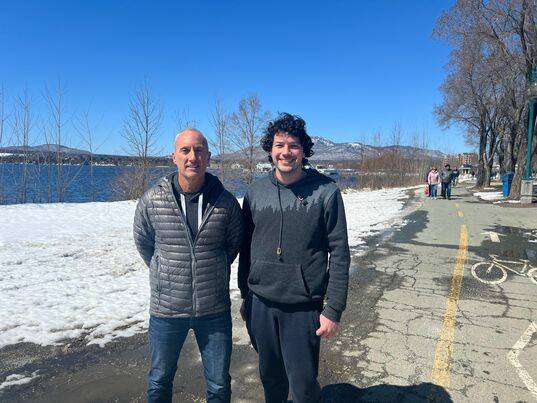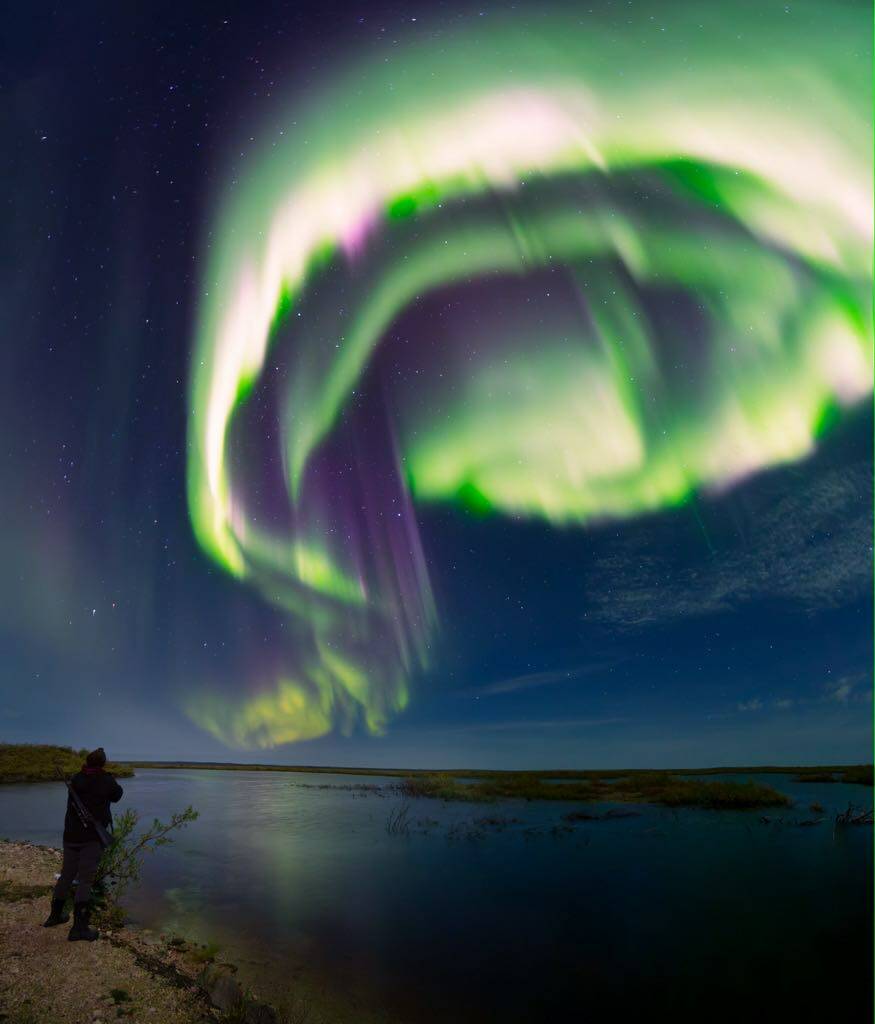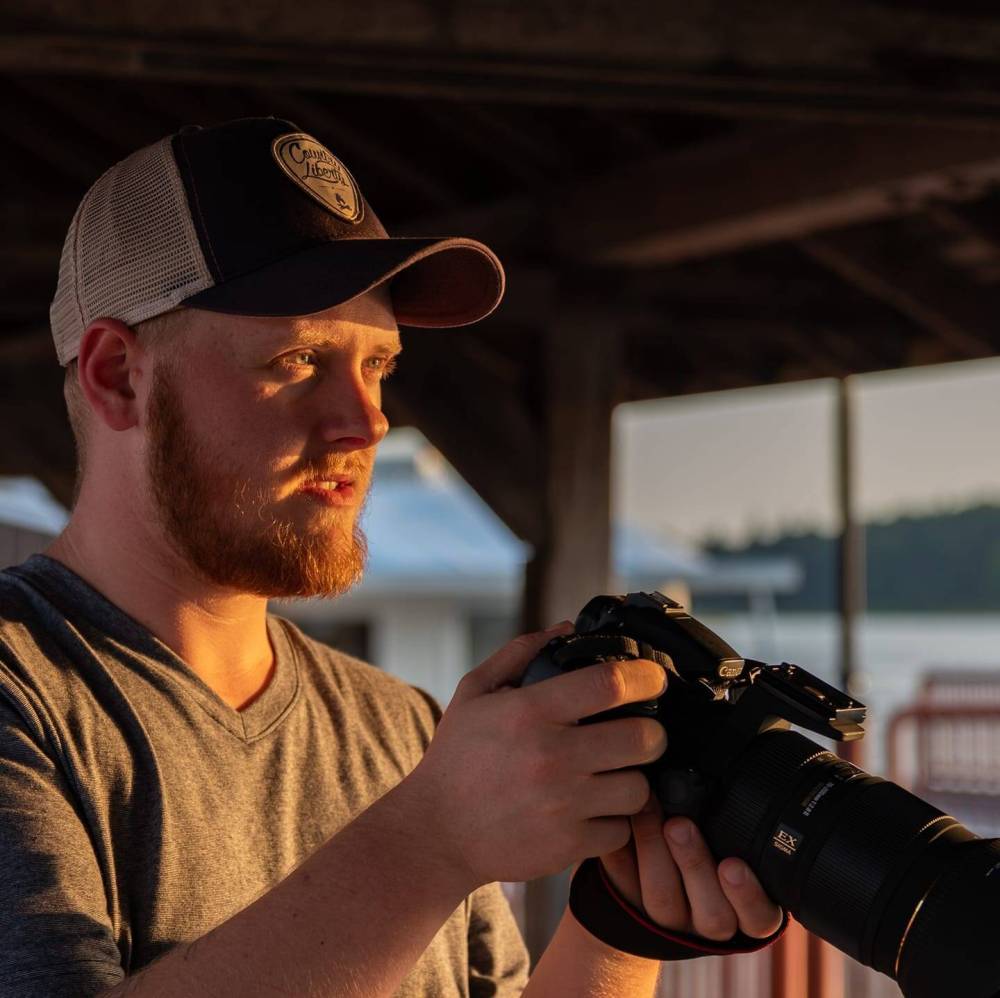Chris Mason can still remember the moment — more than four decades ago — when he watched the moon’s silhouette overtake the sun, temporarily casting his surrounding world into darkness.
“I was in grade school and it was a big deal,” he said Sunday, reflecting on that day in February 1979, when Winnipeg found itself in the path of a total solar eclipse.
“As it gets darker, there’s sort of an eerie calmness that comes over everything. The sound changes, obviously the light changes, it gets cooler. There is a 360-degree sunset… it’s just spectacular and beautiful.”

Winnipeg photographers Chris Mason (left) and Ryan Lucenkiw pictured in Magog, QC, amid a days-long road trip to reach the April 8, 2024, solar eclipse’s “path of totality.” (Submitted)
Mason, 55, is one of several Winnipeg-based photographers who hit the road this weekend in anticipation of Monday’s solar eclipse, which is set to affect parts of North America, from Mazatlan, Mexico, through southeastern Ontario, across Montreal and on through the Maritimes.
Those watching the eclipse in the “path of totality” will see the moon block out the entire sun for as long as four minutes. Partial eclipse viewers will see the moon cover less of the sun’s diameter.
In Winnipeg, a partial eclipse will begin at 12:54 p.m. and will peak at 2:01 p.m., ending just over an hour later.
Mason and fellow photographer Ryan Lucenkiw, 33, left Manitoba early Friday morning, hoping to find an optimal viewing location somewhere within the path.
“We were constantly watching the weather radar and kind of humming and hawing,” Lucenkiw said, describing how the pair drove south to Duluth, Minn., before turning east and skirting along the southern coast of Lake Superior.
They drove for roughly 19 hours on Saturday, ultimately ending up in Magog, Que., on Sunday.
Their plan involved arriving at Lac-Mégantic, Que., sometime before Monday afternoon when the eclipse hits its peak.
“The final destination is, and always has been, negotiable,” Lucenkiw said, laughing.
There they will unpack more than seven cameras and prepare to document the natural phenomenon, which will be the last total eclipse to affect North America until 2044.
For Lucenkiw, it will be his first time experiencing a total eclipse and he wants to share it with others.
“That’s probably thematic of all the photography I do. It’s to help people connect with nature and represent a moment… but even if all of my cameras broke, it would still be worth it,” he said.

Brandon photographer Justin Anderson hopes to photograph the sun’s corona during the total solar eclipse on April 8, 2024. The corona is responsible for creating solar winds that later collide with the earth’s atmosphere, creating the northern lights. (Submitted)
“The way I hear people talk about it, they say it’s a mind-bending experience. Life changing.”
In Ontario, Brandon resident Justin Anderson, 26, is on a road trip with his girlfriend.
The pair are destined for an undetermined location along the northern shores of either Lake Ontario or Lake Erie.
“My excitement has grown more, and more and more,” he said, noting he expected to drive more than 1o hours in total on Monday to reach the optimal spot.
Like Mason and Lucenkiw, Anderson is a photographer with a fascination for astronomy and the natural world.
His work typically focuses on the aurora borealis, so taking photographs during the daytime will be a new challenge, he said.
“I want to photograph the solar wind — the corona of the sun,” Anderson said, describing the outermost part of the sun’s atmosphere, which is typically masked beneath the bright light of its surface.
Massive explosions on the sun, known as coronal mass ejections, release clouds of hot plasma that travel toward Earth and collide with gases in the atmosphere, producing the northern lights.
“In a way, I am still chasing northern lights, I am just chasing them a few days before they get here,” Anderson said.
“We’re just looking forward to it. It’s going to be fun.”

Brandon photographer Justin Anderson typically photographs the aurora borealis, but is looking forward to trying his hand at daytime photography during the total solar eclipse on April 8, 2024.
Anderson originally considered driving to Niagara Falls, Ont., to take in the eclipse there, but the tourist destination is anticipating an influx of up to one million visitors who also want to observe the celestial spectacle.
Officials declared a state of emergency in the Niagara Region owing to the surge in tourism, which could snarl traffic and place increased demands on emergency services and cellphone networks.
The Manitoba Association of Optometrists is urging the public to exercise caution when viewing the eclipse, warning that looking at the sun — even during a total eclipse — can damage the human eye.
Regular sunglasses — even those with UVA and UVB protection — will not provide adequate protection. Instead, viewers should use lenses with special solar filters that adhere to the ISO 12312-2 international standard, the association said.
Some Manitoba schools are planning to keep children indoors during the eclipse to protect pupils from sustaining eye damage.
A free viewing party will take place from 12:30 p.m. to 3:15 p.m. Monday at The Leaf in Assiniboine Park.
tyler.searle@freepress.mb.ca

Tyler Searle
Reporter
Tyler Searle is a multimedia producer who writes for the Free Press’ city desk. Since joining the paper in 2022, he has found himself driving through blizzards, documenting protests and scouring the undersides of bridges for potential stories.